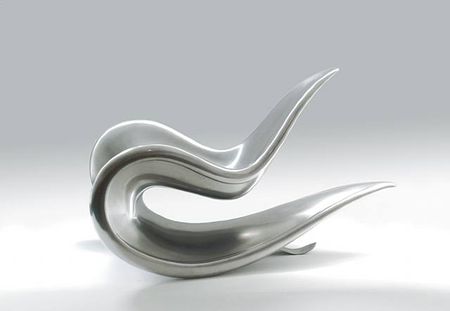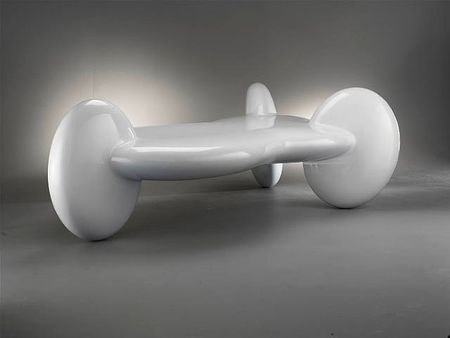Wendell Castle @ Carpenters Workshop Gallery,
Wendell Castle
Abilene, 2008
“The significant thing about my work is not what it is made of but what it is. I would like always to be free to explore all aspects of the useful objects we refer to as ‘furniture.’” Wendell Castle, 2008.
Wendell Castle
Dem Bones, 2007
A long record of critical acclaim, scholarship, and steady acquisition by public institutions gives American artist Wendell Castle’s work indelible historic importance. At 75, his groundbreaking unification of sculpture and furniture galvanized a generation of artists and designers and contributed to the acceptance of design as an art form in its own right. Castle’s work is recognized for its wry wit and uniquely sculptural use of materials. His new body of work exhibited at Carpenters Workshop Gallery explores volume in his signature materials of stack-laminated wood and fibreglass while using a vibrant and unexpected playful spectrum of colour and iridescent texture. He conceives each piece at the drawing board with pen and paper, hand carves his working models and makes each piece himself at his studio in Rochester, upstate New York.
Wendell Castle
Nirvana, 2006
In Nirvana a broad rounded seat rests atop three stylized legs—a device common to several of Castle’s new fibreglass designs—that can be read as references to organic forms or to bullets. A leg pierces one armrest, forming a knob, while the other armrest is attenuated into a horizontal fin that serves as a tabletop. The piece is finished with multiple coatings of automobile-grade “metal-flake” urethane. The paint—a favourite, Castle points out, among hot-rod restorers—is iridescent, and appears to change colours—from blue to purple to aubergine—depending on the angle at which light strikes the surface.
Wendell Castle
Phoenix, 2006
Abilene, a biomorphic stainless steel rocking chair, highlights how integral light has become to Castle in several of his new works. Considering metal forms as cells rather than amoebae, the surface of Abilene is like a semi-permeable membrane, the relationship between the smooth surface and high polish invites light to diffuse, react and reflect on the surface; the sculpture becomes a kind of living organism. Within Abilene, Castle applies his exploration of volume through steel, by creating fleeting and flowing lines Castle discovers a balance between metal and light in what seems like an almost weightless object.
Wendell Castle
Triad Chair, 2006
With this exhibition, Castle is presenting new works in fibreglass. Unlike his earlier designs (including his celebrated Molar Group), which employed relatively simple techniques and straightforward zoomorphic and anthropomorphic forms, his new fibreglass works fully embrace the material, resulting in sensuous, fully actualized volumes with luminous finishes.
These pieces represent a mature synthesis of all that Castle has learned throughout his career, combined with his indefatigable curiosity and excitement in exploration and discovery.
Wendell Castle
Triad Chair, 2006
Wendell Castle, born in Kansas in 1932, has been the subject of and participated in numerous exhibitions at museums and galleries throughout the world. His work can be found in the permanent collections of over 40 museums and cultural institutions, including: the Metropolitan Museum of Art; Museum of Modern Art (New York); Art Institute of Chicago; Smithsonian American Art Museum; Musée des Arts Decoratifs de Montreal; Cooper Hewitt National Design Museum (New York); The Museum of Art and Design (New York); Museum of Fine Arts, Boston; Museum of Fine Arts, Houston; Nordenfieldske Kunstindustrimiseet (Oslo, Norway); Philadelphia Museum of Art; and The White House (Washington, DC), to name only a few. His private patrons are as various as Philippe de Montebello, Martin Margulies, and Thomas Armstrong, while his work can be found in the corporate collections of American Express, Bausch & Lomb, DuPont, Forbes Company, Johnson Wax, Steinway Company, and the Wolfsonian Foundation, among others. He has been the recipient of many honours and awards, including four National Endowment for the Arts grants, three honorary degrees, a Visionaries of the American Craft Movement award from the American Craft Museum (1994), the American Craft Council Gold Medal (1997), Master of the Medium award from The James Renwick Alliance of National Museum of American Art, D.C (1999), and a Lifetime Achievement Award from the Brooklyn Museum of Art (2007). Wendell Castle received a B.F.A. from the University of Kansas in Industrial Design in 1958 and an M.F.A. in sculpture, graduating in 1961. He moved to Rochester, New York to teach at the School of American Craftsmen and established a permanent studio in the area, which is still operating today.
Wendell Castle
Seneca Hall Table (Silver), 2008
Carpenters Workshop Gallery brings design into the contemporary art world producing unique and limited edition pieces. French duo, Loic Le Gaillard and Julien Lombrail, maintain an ambitious exhibition program, presenting works by renowned artists and designers such as Marc Quinn, Atelier Van Lieshout, Ron Arad, Wendell Castle, Pablo Reinoso. The Mayfair based gallery also provides a platform to promote and showcase the careers of contemporary designers, some emerging, such as Robert Stadler, Sebastian Brajkovic, Demakersvan, Ingrid Donat, Vincent Dubourg, Joris Laarman, Xavier Lust and Tejo Remy. Specialising in the converging fields of art and design, Carpenters Workshop Gallery is London’s destination for cutting-edge design art.
8 October - 15 November, 2008. www.cwgdesign.com

/https%3A%2F%2Fprofilepics.canalblog.com%2Fprofilepics%2F1%2F0%2F100183.jpg)
/https%3A%2F%2Fstorage.canalblog.com%2F03%2F02%2F119589%2F96711876_o.jpg)
/https%3A%2F%2Fstorage.canalblog.com%2F11%2F31%2F119589%2F94773502_o.jpg)
/https%3A%2F%2Fstorage.canalblog.com%2F20%2F83%2F119589%2F94772815_o.jpg)
/https%3A%2F%2Fstorage.canalblog.com%2F26%2F72%2F119589%2F75604929_o.jpg)
/https%3A%2F%2Fstorage.canalblog.com%2F59%2F60%2F119589%2F26458628_o.jpg)










/image%2F1371349%2F20240418%2Fob_ac5c4c_telechargement.jpg)
/image%2F1371349%2F20240418%2Fob_709b64_304-1.jpg)
/image%2F1371349%2F20240418%2Fob_22f67e_303-1.jpg)
/image%2F1371349%2F20240417%2Fob_9708e8_telechargement.jpg)